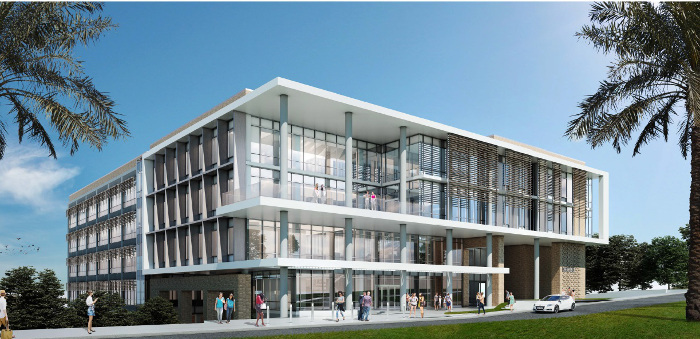COLLABORATION: Multidisciplinary buildings are planned to be built at UCR for efficient research.
By Jacob Ferrall, Staff Writer
A new 150 million dollar multidisciplinary complex at the University of California Riverside (UCR) is planned for completion in the fall of 2018. The 179,000 square foot building will be home to over fifty different teams of scientists. The goal of the project is to bring different fields of sciences such as engineering, chemistry and medicine together to solve problems and to research. Students from different colleges across the UCR campus will collaborate in the work within the facility, and faculty investigators will support them.
Multidisciplinary Research Building 1 (MRB1) broke ground for construction on November 19th near the Materials Science and Engineering Building. UCR’s Chancellor Kim A. Wilcox spoke at the groundbreaking ceremony and declared that the building will, “emphasize this connection between our student life and our research life.” One of the goals of the project is to allow students to be comfortable in a research environment. UCR architect Robert Gayle explains that the building will “address” UCR’s current needs. By being in an optimal location easily accessible from the science facilities, the project aims to please students and faculty alike.
Faculty members claim MRB1 is another step towards fulfilling UCR’s strategic plan: “UCR 2020: The Path to Preeminence.” The plan, originally launched in 2011, is designed to progress benchmarks in research to earn a spot on the Association of American Universities (AAU), an association for top research universities in Canada and the United States. “To achieve our aspirations we need a foundation of strategic investment in people, programs and world class facilities,” Wilcox said. Through the plan, new buildings such as a sports arena, a health center and a few more hospitality centers will be constructed to increase student involvement and success.
UCR is hoping to attain the Leadership in Energy and Environmental Design (LEED) award from the U.S. Green Building Council, which has recently been given to the University of California San Diego (UCSD) for their Health Sciences Biomedical Research Facility II. The 113 million dollar UCSD research facility was built to be energy efficient and environmentally friendly; it recycles water and other materials to ensure low maintenance, and it houses clean air. The facility received a LEED platinum certification, which is the highest level of honor. The team constructing UCR’s building hopes to receive the same award.
Multidisciplinary buildings are not new; a couple recent ones include Indiana University Bloomington’s (IUB) Multidisciplinary Science Building II (2013) and the University of Kansas’ (UK) Multidisciplinary Research Building (2006). IUB’s facility was spaciously built for the Psychology Department’s neuroscience activities, and an underground passage was designed to transport materials from the existing psychology college. The project was created with easily adaptable and interchangeable laboratories for evolving scientific fields. The UK research building focuses on collaborative efforts towards bioinformatics, drug discovery and nanoscience. The multipurpose building includes offices, labs, workrooms and conference rooms. This building and other multidisciplinary buildings such as the Engineering and Health Building in the University of Houston and the Multidisciplinary Science Building in the University of Kentucky, are designed this way to foster productivity and eventually scientific progression.
The strategic plan “UCR 20/20: The Path to Preeminence” and the ambitious construction projects it will pursue could elevate UCR’s status as a major research university and attract more students. A school with more national acclaim will cause Riverside as a whole to grow in recognition. More students attending UCR will lead to more job opportunities at the Riverside Regional Technology Park, which several companies such as Luminex Software have headquarters in. Industry and retail could also see an increase in growth as more students graduate due to the March Air Reserve Base acting as an Inland Empire hub of the shipping company DHL, which generates more jobs. The advancements made on UCR’s campus are a step toward potential improvements of Riverside and the Inland Empire.

